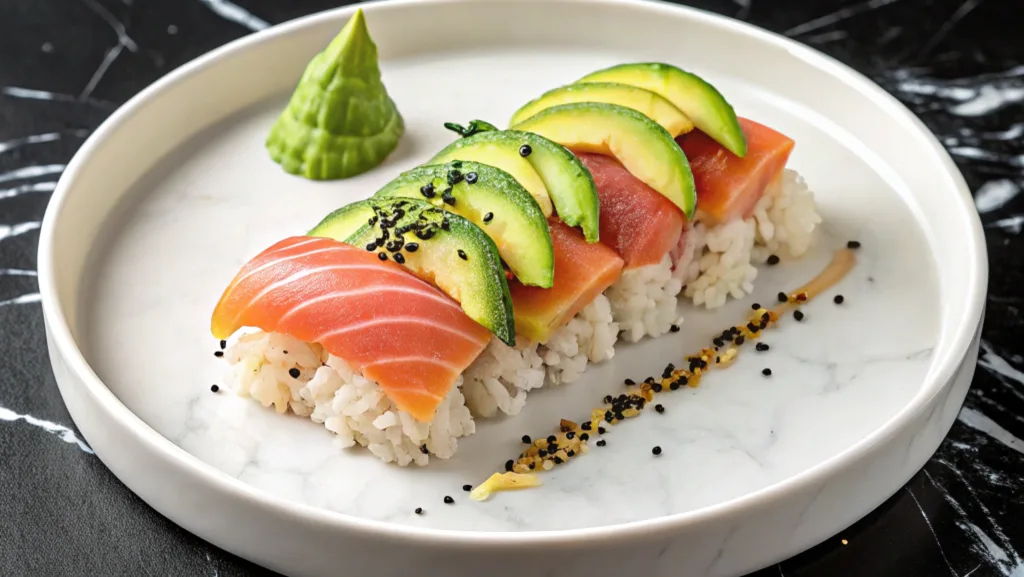Sushi has become a global culinary sensation, admired for its fresh ingredients and unique flavors. But many health-conscious diners often wonder—is sushi healthy?
This guide dives into nutritional insights, health benefits, risks, and practical tips for enjoying sushi without guilt. Along the way, we’ll include internal links and a high-quality external resource to help you make smarter food choices.
Environmental and Ethical Considerations
When asking is an omelette healthier than scrambled eggs, it’s important to consider not just nutrition but also the environmental impact and ethical practices behind egg production. Choosing organic, cage-free, or pasture-raised eggs supports sustainable farming methods, animal welfare, and often results in higher-quality eggs packed with nutrients like omega-3 fatty acids and vitamin D.
1. Organic Eggs
- Produced without pesticides, antibiotics, or genetically modified feed, ensuring cleaner diets for hens and healthier eggs for consumers.
- Organic farms focus on sustainability and avoid chemicals that can harm soil and water sources.
- These eggs often contain higher omega-3s and vitamins, making them a nutrient-rich option for omelettes or scrambled eggs.
2. Cage-Free Eggs
- Hens are raised in open spaces, allowing them to exhibit natural behaviors like perching and dust-bathing.
- While not always given outdoor access, cage-free systems offer better living conditions compared to battery cages.
- Eggs from cage-free systems support reduced stress and improved animal welfare, making them a more ethical choice for health-conscious consumers.
3. Pasture-Raised Eggs
- Hens raised on pasture have access to outdoor foraging, where they can consume natural diets including plants and insects.
- These eggs are richer in omega-3 fatty acids, vitamin E, and beta-carotene, enhancing their nutritional value whether used in omelettes or scrambled eggs.
- Pasture-raised systems also promote soil regeneration, biodiversity, and reduced environmental impact through sustainable farming practices.
4. Local and Sustainable Farming
- Buying eggs from local farms reduces the carbon footprint associated with transportation and mass production.
- Supporting small-scale farmers encourages eco-friendly practices such as composting, renewable energy usage, and minimal waste generation.
- Locally sourced eggs are often fresher and more flavorful, perfect for healthy breakfast options like vegetable-packed omelettes or low-fat scrambled eggs.
5. Ethical Labels to Look For
When purchasing eggs, look for certifications that prioritize ethical farming practices, including:
- USDA Organic – Ensures eggs are produced without pesticides or antibiotics.
- Certified Humane® – Guarantees humane treatment of hens.
- Animal Welfare Approved – Recognized for its high standards in animal care.
Health Benefits of Eating Sushi
Sushi is not only a delicious and versatile dish but also offers numerous health benefits due to its nutrient-rich ingredients. From heart-healthy fats to digestive support, sushi can be an excellent addition to a balanced diet when consumed mindfully.
1. Heart-Healthy Fats
Fish like salmon, tuna, and mackerel are rich in omega-3 fatty acids, which have been shown to:
- Reduce inflammation and lower blood pressure.
- Decrease cholesterol levels, promoting heart health.
- Support brain function and reduce the risk of neurodegenerative diseases.
Tip: Opt for sushi varieties featuring raw fish or grilled options to maximize the heart-healthy benefits without added fats from frying.
For more inspiration, check out this recipe for Healthy Cajun Shrimp Pasta that combines lean proteins and vegetables for a balanced seafood-based meal.
2. Weight Management
 Sushi is generally low in calories, particularly options like:
Sushi is generally low in calories, particularly options like:
- Sashimi (thinly sliced raw fish) – Pure protein with minimal fat.
- Cucumber rolls – Light, low-carb options perfect for calorie-conscious eaters.
- Brown rice sushi – Adds fiber and whole grains for sustained energy.
To keep sushi lean, avoid:
- Fried rolls (tempura) and creamy sauces, which can be high in calories and saturated fats.
- Excessive soy sauce, which may increase sodium intake.
Pairing sushi with a side salad or edamame enhances fiber intake and supports portion control.
3. Digestive Health
Sushi ingredients like seaweed and vegetables promote gut health:
- Seaweed (nori) is rich in iodine, which supports thyroid function, and provides fiber for digestive balance.
- Ginger, often served with sushi, has anti-inflammatory properties and aids in digestion.
- Pickled vegetables (like radish) are natural probiotics, promoting a healthy gut microbiome.
Adding a small serving of miso soup as a starter can further improve digestion with its probiotic content.
4. Protein-Packed for Muscle Health
Sushi, especially sashimi, is an excellent source of lean protein, which:
- Supports muscle repair and growth.
- Keeps you fuller longer, aiding in weight management.
- Provides amino acids essential for cell repair and immune function.
5. Rich in Antioxidants and Vitamins
Sushi ingredients offer a wide range of antioxidants, vitamins, and minerals:
- Avocado – High in healthy fats, Vitamin E, and potassium for heart health.
- Cucumber – Hydrating and rich in Vitamin K for bone health.
- Wasabi – Contains antimicrobial properties and aids in circulation.
Final Thoughts
Sushi can be a healthy and satisfying meal when enjoyed in moderation and paired with nutrient-dense ingredients. Opt for lean protein sources, vegetables, and whole grains to create a balanced plate that supports heart health, weight management, and digestive wellness.
For more insights into the health benefits of fish, visit the Harvard T.H. Chan School of Public Health to learn how omega-3s support cardiovascular and brain health.
Potential Risks of Eating Sushi
While sushi offers numerous health benefits, it’s essential to be aware of potential risks associated with its consumption. By understanding these concerns and taking proper precautions, you can continue to enjoy sushi safely.
1. Mercury Levels
Certain fish, particularly predatory species like tuna, swordfish, and mackerel, may contain high levels of mercury. Consuming too much mercury can lead to:
- Neurological issues such as memory loss or cognitive impairment.
- Risks for pregnant women and young children, as mercury affects fetal development.
How to Reduce Risk:
- Opt for low-mercury fish like salmon, shrimp, and tilapia.
- Limit high-mercury fish to once or twice a week to avoid toxicity.
- Check FDA guidelines for safe fish consumption levels.
2. Foodborne Illnesses
Raw fish can sometimes carry parasites, bacteria, or viruses that may cause foodborne illnesses like:
- Salmonella – Leads to nausea, vomiting, and diarrhea.
- Anisakiasis – A parasitic infection that can result in abdominal pain and nausea.
- Listeria – Particularly dangerous for pregnant women, older adults, and individuals with weakened immune systems.
How to Reduce Risk:
- Choose sushi-grade fish, which is frozen at temperatures low enough to kill parasites.
- Eat sushi from reputable restaurants that follow strict food safety standards.
- Opt for cooked options, such as eel rolls or shrimp tempura, if safety is a concern.
For more details on safe sushi practices, check out What Fish is Safe to Eat Raw.
3. Sodium Overload
Sushi accompaniments like soy sauce, pickled ginger, and wasabi may contain high levels of sodium, which can:
- Contribute to high blood pressure and fluid retention.
- Increase the risk of heart disease if consumed in excess.
How to Reduce Risk:
- Use low-sodium soy sauce or tamari as alternatives.
- Limit dipping sauces and instead flavor sushi with lemon juice or wasabi.
- Balance meals with water-rich vegetables like cucumber and avocado to offset sodium intake.
4. Allergies and Sensitivities
- Sushi often includes shellfish, sesame seeds, and soy, which are common allergens.
- Cross-contamination may occur, especially in shared preparation areas.
How to Reduce Risk:
- Inform your server of allergies and ask about ingredients.
- Choose simpler rolls without sauces or toppings that may contain hidden allergens.
5. Overeating Refined Carbs
Many sushi rolls contain white rice, which is low in fiber and can cause blood sugar spikes when eaten in large quantities.
How to Reduce Risk:
- Opt for rolls made with brown rice for added fiber and nutrients.
- Limit portions and pair sushi with protein-rich sides like edamame or miso soup.
Best and Worst Sushi Options
Healthiest Choices

- Sashimi – Pure protein with no carbs and rich in omega-3 fatty acids, ideal for low-carb diets.
- Avocado Rolls – Packed with healthy fats and fiber, promoting heart health and satiety.
- Cucumber Rolls – Low-calorie, hydrating, and high in fiber, perfect for weight management.
- Brown Rice Rolls – Provide complex carbs and fiber, offering long-lasting energy and better blood sugar control.
Unhealthiest Choices
- Tempura Rolls – Deep-fried and calorie-dense, high in saturated fats and refined carbs, making them less suitable for weight loss.
- Spicy Tuna Rolls – Often mixed with mayonnaise-based sauces, adding extra fats and calories while reducing nutritional value.
- Dragon Rolls – Topped with sweet glazes and fried ingredients, making them high in sugar, fat, and sodium, which can hinder heart health goals.
Tip: Opt for sushi varieties with vegetables, lean proteins, and brown rice to create a more balanced and nutritious meal without sacrificing flavor.
Making Healthier Sushi Choices
Enjoying sushi can be both delicious and nutritious when you make smart choices. Follow these simple tips to savor sushi without compromising your health goals:
- Replace white rice with brown rice – Brown rice offers more fiber, vitamins, and minerals, promoting better digestion and stable blood sugar levels.
- Opt for low-sodium soy sauce or skip it entirely – High sodium intake can lead to water retention and high blood pressure. Choose low-sodium alternatives or flavor your sushi with wasabi and lemon juice.
- Choose vegetable-based rolls – Rolls filled with cucumber, avocado, carrots, or seaweed are low-calorie, rich in fiber, and loaded with antioxidants.
- Avoid fried ingredients or creamy sauces – Skip tempura rolls and mayonnaise-based sauces to reduce calories and saturated fats. Instead, go for fresh, raw fish or grilled options for lean protein.
- Pair sushi with healthy sides – Add edamame for protein and fiber, or enjoy a bowl of miso soup for its probiotics, which support gut health and digestion.
- Balance portions – Sushi can be carb-heavy, so balance your meal with protein-rich additions like sashimi or a side salad with sesame dressing.
Looking for more protein-packed recipes? Try this Protein Baked Oatmeal to fuel your mornings and complement a healthy diet.
FAQs Is Sushi Health
1. Is sushi good for weight loss?
Yes, especially low-calorie options like sashimi and veggie rolls. Avoid fried rolls and creamy sauces.
2. Can I eat sushi every day?
Limit raw fish to avoid mercury exposure. Rotate fish types for safety.
3. Is sushi safe during pregnancy?
Pregnant women should avoid raw fish and opt for vegetable rolls.
4. What’s the healthiest sushi option?
Salmon sashimi and avocado rolls are nutrient-dense choices.
5. Does sushi have added sugar?
Yes, sushi rice often contains vinegar and sugar. Opt for brown rice as a lower-sugar option.
Homemade Sushi for Healthier Options
 Making sushi at home allows you to control ingredients and portion sizes. Use:
Making sushi at home allows you to control ingredients and portion sizes. Use:
- Brown rice or cauliflower rice.
- Vegetables and lean proteins.
- Limit sauces and fried toppings.
Final Thoughts
So, is sushi healthy? It can be a nutritional powerhouse when prepared mindfully. Sushi offers heart-healthy fats, low-calorie options, and digestive benefits. However, be mindful of mercury, calories, and sodium levels.
By choosing simpler rolls, vegetable-based options, and lean proteins, you can enjoy sushi as part of a balanced diet. Explore recipes like Healthy Cajun Shrimp Pasta for more inspiration.
Let me know if you’d like additional edits or enhancements!

